Jianhua Li
StyleDecipher: Robust and Explainable Detection of LLM-Generated Texts with Stylistic Analysis
Oct 14, 2025Abstract:With the increasing integration of large language models (LLMs) into open-domain writing, detecting machine-generated text has become a critical task for ensuring content authenticity and trust. Existing approaches rely on statistical discrepancies or model-specific heuristics to distinguish between LLM-generated and human-written text. However, these methods struggle in real-world scenarios due to limited generalization, vulnerability to paraphrasing, and lack of explainability, particularly when facing stylistic diversity or hybrid human-AI authorship. In this work, we propose StyleDecipher, a robust and explainable detection framework that revisits LLM-generated text detection using combined feature extractors to quantify stylistic differences. By jointly modeling discrete stylistic indicators and continuous stylistic representations derived from semantic embeddings, StyleDecipher captures distinctive style-level divergences between human and LLM outputs within a unified representation space. This framework enables accurate, explainable, and domain-agnostic detection without requiring access to model internals or labeled segments. Extensive experiments across five diverse domains, including news, code, essays, reviews, and academic abstracts, demonstrate that StyleDecipher consistently achieves state-of-the-art in-domain accuracy. Moreover, in cross-domain evaluations, it surpasses existing baselines by up to 36.30%, while maintaining robustness against adversarial perturbations and mixed human-AI content. Further qualitative and quantitative analysis confirms that stylistic signals provide explainable evidence for distinguishing machine-generated text. Our source code can be accessed at https://github.com/SiyuanLi00/StyleDecipher.
Fre-CW: Targeted Attack on Time Series Forecasting using Frequency Domain Loss
Aug 12, 2025Abstract:Transformer-based models have made significant progress in time series forecasting. However, a key limitation of deep learning models is their susceptibility to adversarial attacks, which has not been studied enough in the context of time series prediction. In contrast to areas such as computer vision, where adversarial robustness has been extensively studied, frequency domain features of time series data play an important role in the prediction task but have not been sufficiently explored in terms of adversarial attacks. This paper proposes a time series prediction attack algorithm based on frequency domain loss. Specifically, we adapt an attack method originally designed for classification tasks to the prediction field and optimize the adversarial samples using both time-domain and frequency-domain losses. To the best of our knowledge, there is no relevant research on using frequency information for time-series adversarial attacks. Our experimental results show that these current time series prediction models are vulnerable to adversarial attacks, and our approach achieves excellent performance on major time series forecasting datasets.
Model-Agnostic Sentiment Distribution Stability Analysis for Robust LLM-Generated Texts Detection
Aug 09, 2025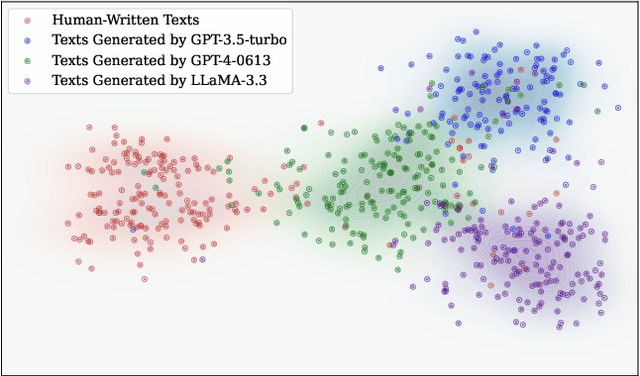

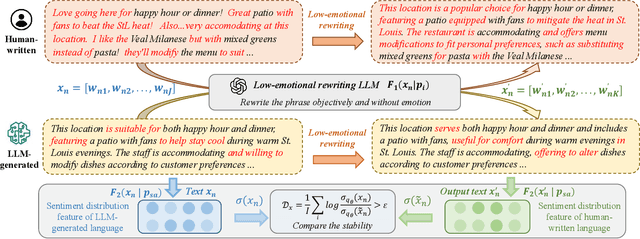

Abstract:The rapid advancement of large language models (LLMs) has resulted in increasingly sophisticated AI-generated content, posing significant challenges in distinguishing LLM-generated text from human-written language. Existing detection methods, primarily based on lexical heuristics or fine-tuned classifiers, often suffer from limited generalizability and are vulnerable to paraphrasing, adversarial perturbations, and cross-domain shifts. In this work, we propose SentiDetect, a model-agnostic framework for detecting LLM-generated text by analyzing the divergence in sentiment distribution stability. Our method is motivated by the empirical observation that LLM outputs tend to exhibit emotionally consistent patterns, whereas human-written texts display greater emotional variability. To capture this phenomenon, we define two complementary metrics: sentiment distribution consistency and sentiment distribution preservation, which quantify stability under sentiment-altering and semantic-preserving transformations. We evaluate SentiDetect on five diverse datasets and a range of advanced LLMs,including Gemini-1.5-Pro, Claude-3, GPT-4-0613, and LLaMa-3.3. Experimental results demonstrate its superiority over state-of-the-art baselines, with over 16% and 11% F1 score improvements on Gemini-1.5-Pro and GPT-4-0613, respectively. Moreover, SentiDetect also shows greater robustness to paraphrasing, adversarial attacks, and text length variations, outperforming existing detectors in challenging scenarios.
AuditVotes: A Framework Towards More Deployable Certified Robustness for Graph Neural Networks
Mar 29, 2025Abstract:Despite advancements in Graph Neural Networks (GNNs), adaptive attacks continue to challenge their robustness. Certified robustness based on randomized smoothing has emerged as a promising solution, offering provable guarantees that a model's predictions remain stable under adversarial perturbations within a specified range. However, existing methods face a critical trade-off between accuracy and robustness, as achieving stronger robustness requires introducing greater noise into the input graph. This excessive randomization degrades data quality and disrupts prediction consistency, limiting the practical deployment of certifiably robust GNNs in real-world scenarios where both accuracy and robustness are essential. To address this challenge, we propose \textbf{AuditVotes}, the first framework to achieve both high clean accuracy and certifiably robust accuracy for GNNs. It integrates randomized smoothing with two key components, \underline{au}gmentation and con\underline{dit}ional smoothing, aiming to improve data quality and prediction consistency. The augmentation, acting as a pre-processing step, de-noises the randomized graph, significantly improving data quality and clean accuracy. The conditional smoothing, serving as a post-processing step, employs a filtering function to selectively count votes, thereby filtering low-quality predictions and improving voting consistency. Extensive experimental results demonstrate that AuditVotes significantly enhances clean accuracy, certified robustness, and empirical robustness while maintaining high computational efficiency. Notably, compared to baseline randomized smoothing, AuditVotes improves clean accuracy by $437.1\%$ and certified accuracy by $409.3\%$ when the attacker can arbitrarily insert $20$ edges on the Cora-ML datasets, representing a substantial step toward deploying certifiably robust GNNs in real-world applications.
Splats in Splats: Embedding Invisible 3D Watermark within Gaussian Splatting
Dec 04, 2024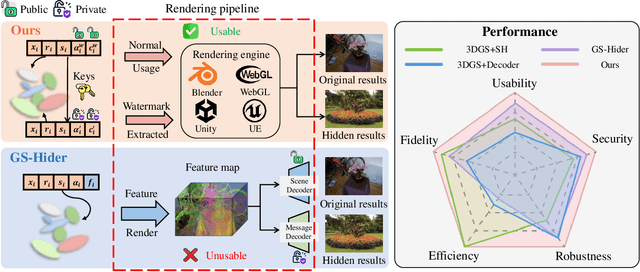

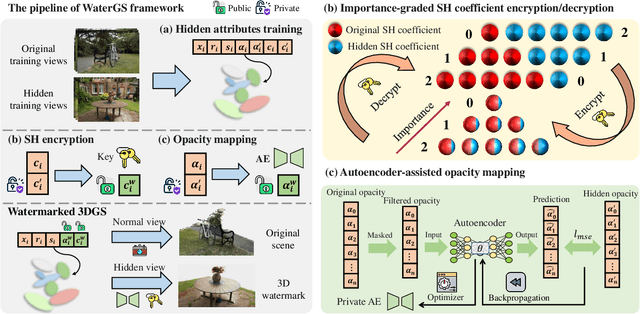
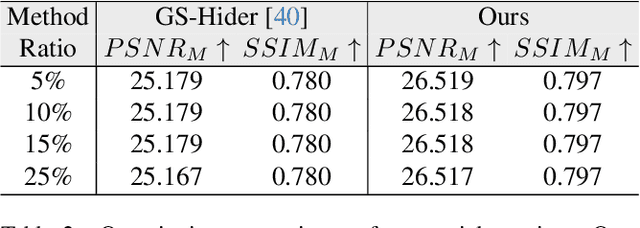
Abstract:3D Gaussian splatting (3DGS) has demonstrated impressive 3D reconstruction performance with explicit scene representations. Given the widespread application of 3DGS in 3D reconstruction and generation tasks, there is an urgent need to protect the copyright of 3DGS assets. However, existing copyright protection techniques for 3DGS overlook the usability of 3D assets, posing challenges for practical deployment. Here we describe WaterGS, the first 3DGS watermarking framework that embeds 3D content in 3DGS itself without modifying any attributes of the vanilla 3DGS. To achieve this, we take a deep insight into spherical harmonics (SH) and devise an importance-graded SH coefficient encryption strategy to embed the hidden SH coefficients. Furthermore, we employ a convolutional autoencoder to establish a mapping between the original Gaussian primitives' opacity and the hidden Gaussian primitives' opacity. Extensive experiments indicate that WaterGS significantly outperforms existing 3D steganography techniques, with 5.31% higher scene fidelity and 3X faster rendering speed, while ensuring security, robustness, and user experience. Codes and data will be released at https://water-gs.github.io.
SFR-GNN: Simple and Fast Robust GNNs against Structural Attacks
Sep 01, 2024



Abstract:Graph Neural Networks (GNNs) have demonstrated commendable performance for graph-structured data. Yet, GNNs are often vulnerable to adversarial structural attacks as embedding generation relies on graph topology. Existing efforts are dedicated to purifying the maliciously modified structure or applying adaptive aggregation, thereby enhancing the robustness against adversarial structural attacks. It is inevitable for a defender to consume heavy computational costs due to lacking prior knowledge about modified structures. To this end, we propose an efficient defense method, called Simple and Fast Robust Graph Neural Network (SFR-GNN), supported by mutual information theory. The SFR-GNN first pre-trains a GNN model using node attributes and then fine-tunes it over the modified graph in the manner of contrastive learning, which is free of purifying modified structures and adaptive aggregation, thus achieving great efficiency gains. Consequently, SFR-GNN exhibits a 24%--162% speedup compared to advanced robust models, demonstrating superior robustness for node classification tasks.
Performance Analysis of Photon-Limited Free-Space Optical Communications with Practical Photon-Counting Receivers
Aug 24, 2024Abstract:The non-perfect factors of practical photon-counting receiver are recognized as a significant challenge for long-distance photon-limited free-space optical (FSO) communication systems. This paper presents a comprehensive analytical framework for modeling the statistical properties of time-gated single-photon avalanche diode (TG-SPAD) based photon-counting receivers in presence of dead time, non-photon-number-resolving and afterpulsing effect. Drawing upon the non-Markovian characteristic of afterpulsing effect, we formulate a closed-form approximation for the probability mass function (PMF) of photon counts, when high-order pulse amplitude modulation (PAM) is used. Unlike the photon counts from a perfect photon-counting receiver, which adhere to a Poisson arrival process, the photon counts from a practical TG-SPAD based receiver are instead approximated by a binomial distribution. Additionally, by employing the maximum likelihood (ML) criterion, we derive a refined closed-form formula for determining the threshold in high-order PAM, thereby facilitating the development of an analytical model for the symbol error rate (SER). Utilizing this analytical SER model, the system performance is investigated. The numerical results underscore the crucial need to suppress background radiation below the tolerated threshold and to maintain a sufficient number of gates in order to achieve a target SER.
A Novel Signal Detection Method for Photon-Counting Communications with Nonlinear Distortion Effects
Aug 20, 2024



Abstract:This paper proposes a method for estimating and detecting optical signals in practical photon-counting receivers. There are two important aspects of non-perfect photon-counting receivers, namely, (i) dead time which results in blocking loss, and (ii) non-photon-number-resolving, which leads to counting loss during the gate-ON interval. These factors introduce nonlinear distortion to the detected photon counts. The detected photon counts depend not only on the optical intensity but also on the signal waveform, and obey a Poisson binomial process. Using the discrete Fourier transform characteristic function (DFT-CF) method, we derive the probability mass function (PMF) of the detected photon counts. Furthermore, unlike conventional methods that assume an ideal rectangle wave, we propose a novel signal estimation and decision method applicable to arbitrary waveform. We demonstrate that the proposed method achieves superior error performance compared to conventional methods. The proposed algorithm has the potential to become an essential signal processing tool for photon-counting receivers.
rLLM: Relational Table Learning with LLMs
Jul 29, 2024
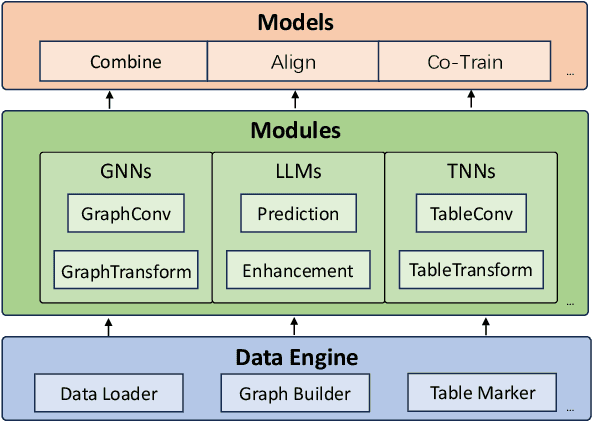

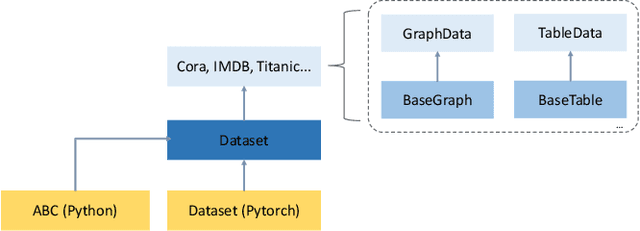
Abstract:We introduce rLLM (relationLLM), a PyTorch library designed for Relational Table Learning (RTL) with Large Language Models (LLMs). The core idea is to decompose state-of-the-art Graph Neural Networks, LLMs, and Table Neural Networks into standardized modules, to enable the fast construction of novel RTL-type models in a simple "combine, align, and co-train" manner. To illustrate the usage of rLLM, we introduce a simple RTL method named \textbf{BRIDGE}. Additionally, we present three novel relational tabular datasets (TML1M, TLF2K, and TACM12K) by enhancing classic datasets. We hope rLLM can serve as a useful and easy-to-use development framework for RTL-related tasks. Our code is available at: https://github.com/rllm-project/rllm.
OpticGAI: Generative AI-aided Deep Reinforcement Learning for Optical Networks Optimization
Jun 22, 2024



Abstract:Deep Reinforcement Learning (DRL) is regarded as a promising tool for optical network optimization. However, the flexibility and efficiency of current DRL-based solutions for optical network optimization require further improvement. Currently, generative models have showcased their significant performance advantages across various domains. In this paper, we introduce OpticGAI, the AI-generated policy design paradigm for optical networks. In detail, it is implemented as a novel DRL framework that utilizes generative models to learn the optimal policy network. Furthermore, we assess the performance of OpticGAI on two NP-hard optical network problems, Routing and Wavelength Assignment (RWA) and dynamic Routing, Modulation, and Spectrum Allocation (RMSA), to show the feasibility of the AI-generated policy paradigm. Simulation results have shown that OpticGAI achieves the highest reward and the lowest blocking rate of both RWA and RMSA problems. OpticGAI poses a promising direction for future research on generative AI-enhanced flexible optical network optimization.
 Add to Chrome
Add to Chrome Add to Firefox
Add to Firefox Add to Edge
Add to Edge